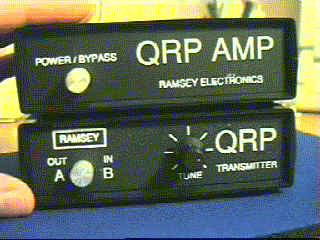

The Ramsey Transmitter
The picture shows a Ramsey 40m QRP transmitter and companion 40m linear. Both were built from kits, although the custom cases are an additional (rather expensive) option. The same basic single-band design is available in versions for the 80, 40, 30 and 20 metre bands.
Verdict? A super little rig. Excellent kit quality and clear instructions. It would be hard to go wrong even if you had never used a soldering iron before.
Building time - about 3 to 4 hours. Worked first time.
The Ramsey Linear Amplifier
The companion linear amplifier uses a pair of 2N10E power MOSFETS and RF sensing changeover. Like the 40m transmitter, this is a really nice kit with excellent instructions. It includes all ferrites and a particularly impressive large “binocular” used for the output transformer. There are very clear illustrations of winding details. First attempts to set the bias suggested self-oscillation, with the current suddenly jumping up and the power MOSFETs getting very, very hot. The output transformer was also warming up. Fitting ferrite beads to the MOSFET drains fixed the problem completely, but there was nothing in the trouble-shooting hints that covered parasitic oscillation. A pity, because this would have defeated most beginners, though the solution was simple.
Results? The linear has a x10 power gain and delivers 10W out driven with the Ramsey transmitter. (I put a 220uf electrolytic across the changeover relay to give a “semi QSK” effect. I didn’t like it rattling away on every key-down). Driven with SSB from my Mizuho 40m hand-held, the linear peaks at 25W output (!!) with a 14v supply. Quality is good without any “spiky” noises on adjacent frequencies. The RF changeover is very sensitive and the residual carrier from the Mizuho is sufficient to hold it in while the PTT is pressed. Early high-temperature experiences with parasitics indicated that the MOSFETs are almost indestructible, but I was concerned that the small PA heatsinks were getting very hot. For peace of mind, I fitted a miniature blower into the lid of the case and cut a similar sized exhaust outlet in the underside. The tiny fan came from a defunct Pentium CPU (one of the early ones with the floating point bug). Now, the whole thing stays cool even when used continuously at 20W output.
Verdict? Shame about the parasitics which would have caused most beginners to junk the project. Otherwise - excellent. Building time 2-3 hours. Debugging / fixing time about the same.
Paul Tuton G0UBV
ptuton@ptuton.demon.co.uk